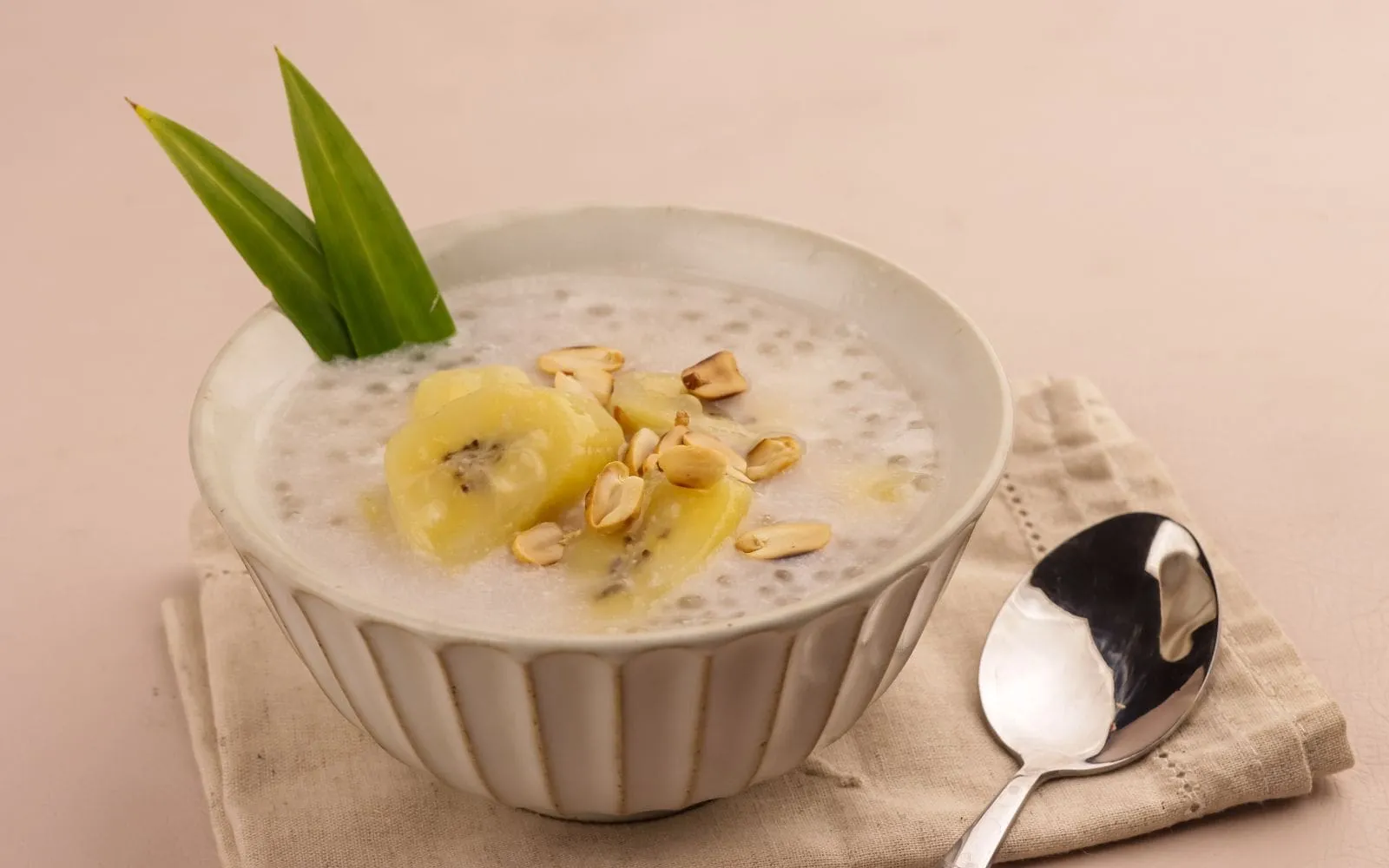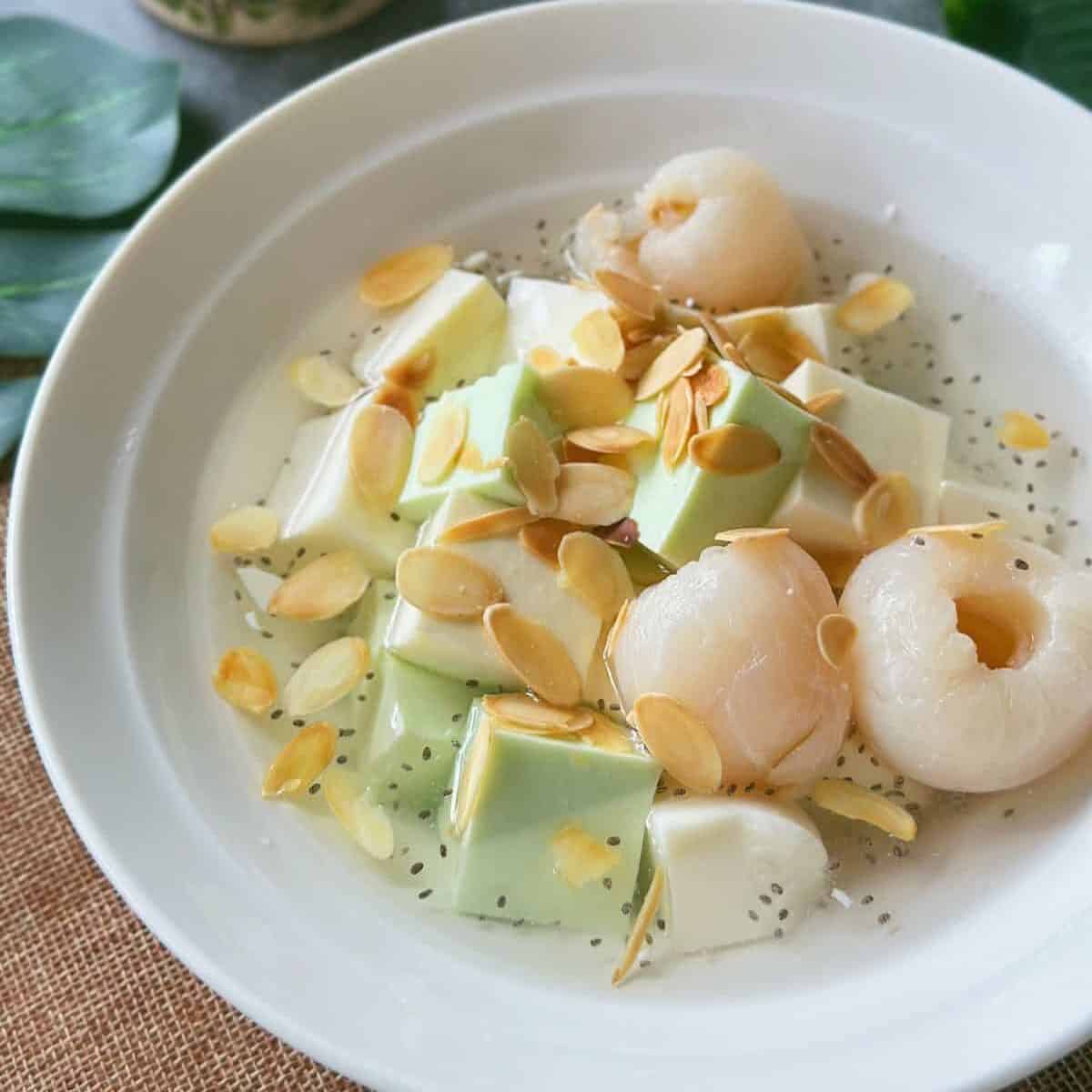Growing up in Vietnam, one of my favorite moments was waiting for Mom to come home with a small bag of Chè.
Warm or chilled, it wasn’t just dessert — it was comfort, sweetness, and a little pocket of childhood joy all in one.

In Vietnam, Chè comes in countless forms — from North to South, hot or cold, it’s perfect for every season. It cools you in sticky summer heat and warms you on rainy winter days.
You’ll find it everywhere — street corners, restaurants, or simmering in a family kitchen. Chè isn’t just dessert — it’s a bite of our culture, a sprinkle of childhood memories, and a little everyday joy.
- What Exactly Is Chè?
- Chè Across Vietnam’s Three Regions
- Popular Ingredients for Chè
- 1. Chè Đậu Xanh (Mungbean Dessert Soup)
- 2. Chè Chuối (Banana & Sago Dessert Soup)
- 3. Chè Ba Màu (Three Color Dessert Soup)
- 4. Chè Đậu Trắng (Black-eyed Pea Dessert Soup)
- 5. Chè Thái (Vietnamese Fruit Cocktail)
- 6. Chè Bà Ba (Sweet Soup with Sweet Potato, Taro, and Cassava)
- 7. Chè Trôi Nước (Sweet Rice Ball Soup)
- 8. Chè Bắp (Sweet Corn Pudding)
- 9. Chè Khoai Môn (Taro Pudding)
- 10. Chè Khúc Bạch (Panna Cotta Dessert Soup) (with recipe)
- 11. Sâm Bổ Lượng (Ching Bo Leung)
What Exactly Is Chè?
If you grew up in Vietnam, Chè is probably a sweet thread woven through your childhood.
Think of it as our take on Cantonese Tong Sui (糖水) — dessert soups from Southern China that somehow feel perfectly at home here.

Chè comes in two main moods. There’s chè nóng — warm, creamy, and comforting, perfect for a drizzly afternoon or a cool evening.
Then there’s chè đá — light, chilled, and refreshing, made for sticky, sun-baked summer days.
Vietnam loves to welcome sweet soups from abroad, too. Hong Kong’s “Pomelo Mango Sago” (chè xoài bột báng)? Sure. Malaysia’s “Bubur Cha Cha” (chè bô bô cha cha)? Absolutely. If it’s sweet, soupy, and comforting, it can be chè.
Chè Across Vietnam’s Three Regions
In Huế, the former imperial capital, you’ll find chè cung đình — royal-style chè — alongside local favorites like bun bo Hue, ca phe muoi, and delicate dumplings (bánh nậm, bánh bèo…).
The star? Chè bột lọc heo quay, chewy tapioca dumplings hiding crispy pork belly. Sounds unusual? Somehow, it works — and you’ll be hooked.

Hanoi’s chè is gentler — lightly sweet, clean, and comforting. After a steaming bowl of Pho or Bun Cha, I love ending the day with Chè Đậu Đen (black bean dessert soup) — simple, earthy, and quietly satisfying.

Saigon brings bold flavors: rich, coconut-based Vietnamese chè and Chinese-style chè (chè người Hoa), usually without coconut.
In Chợ Lớn, Saigon’s Chinatown, this cultural mix shows up everywhere — from bo bia and bánh bao to com ga Hai Nam, and of course, in the chè.

No matter where you go in Vietnam, chè is there — a little bowl of sweetness carrying our culture, our history, and, for many of us, a taste of childhood.
Popular Ingredients for Chè
One of the best things about chè is that no two bowls are ever the same. With so many varieties across Vietnam, the ingredients are as colorful and lively as a bustling market.
Legumes & Seeds – Mung beans, black beans, red beans, black-eyed peas, lotus seeds, and even fragrant black sesame seeds.
Grains & Cereals – Sticky rice for that comforting chew, and sweet corn that pops with sunshine in every bite.
Tubers – Soft, melting sweet potatoes, earthy taro, jewel-like purple yams (ube), and cassava that soaks up every drop of sweetness.
Vegetables & Seaweed – Cooling aloe vera, slippery kelp, crunchy lotus root, refreshing water chestnuts, tender coconut meat, and tiny hột é (Thai basil seeds) that turn into little jelly-like pearls.
Jellies & Sweet Dumplings – Grass jelly, aiyu jelly, agar-agar, coffee jelly, sago pearls, boba pearls, and pastel taro balls that almost look too pretty to eat.
Puddings – Creamy Vietnamese flan, silky panna cotta, or soft egg custard that melts in your mouth.
Fruits – Banana, jackfruit, durian, lychee… each adding its own fragrance and sweetness.
The best part? You get to build your own bowl.
Pick your favorites, pour over some nuoc cot dua (sweetened coconut milk), top with crushed ice, and suddenly you’ve got a chè that’s entirely yours — a little bowl of joy you’ll want to savor, spoonful by spoonful.
1. Chè Đậu Xanh (Mungbean Dessert Soup)
Chè Đậu Xanh can be made with whole mung beans for a gentle, textured bite or split beans for a smooth, creamy spoonful.
Warm, it’s cozy and comforting on a drizzly day; chilled, it’s a refreshing little sigh on a hot afternoon.

There are a few favorite twists, too. Chè Đậu Xanh Đánh turns mung beans into a silky, pudding-like paste, while Chè Bưởi combines mung beans with tender pomelo rind in a sweet, floral soup.
2. Chè Chuối (Banana & Sago Dessert Soup)
In Chè Chuối, ripe Lady Finger bananas are gently simmered with coconut milk and sago pearls until everything melds into a warm, creamy sweetness.

For an extra indulgence, try Chè Chuối Nướng — grilled bananas wrapped in sticky rice, drenched in coconut sauce, then baked until golden and caramelized at the edges.
3. Chè Ba Màu (Three Color Dessert Soup)
Chè Ba Màu is pure joy in a glass — bright, playful, and almost too pretty to eat. Three cheerful layers catch your eye: ruby-red water chestnut pearls, soft green pandan jelly or cendol, and golden mung bean paste.

Pour over the coconut sauce, let the crushed ice start to melt, and the colors swirl into a sweet, creamy, icy mix that’s as refreshing as it is fun — a little bowl of happiness with every spoonful.
4. Chè Đậu Trắng (Black-eyed Pea Dessert Soup)
In Vietnam, black-eyed peas are called đậu trắng — “white beans” — a humble name for such a comforting ingredient.
In Chè Đậu Trắng, the beans are slow-cooked with sticky rice until they melt into a cozy, pudding-like mix, then finished with a drizzle of rich coconut milk for that extra touch of warmth and sweetness.

5. Chè Thái (Vietnamese Fruit Cocktail)
Vietnam has a funny habit of borrowing names from Thailand — lẩu Thái, bún Thái, and of course chè Thái — even if you won’t find these exact versions there. They’re really our own playful twists on Thai-inspired flavors.
Chè Thái is like a tropical fruit party in a glass. Fresh Vietnamese fruits, colorful jellies, and creamy coconut sauce come together for a sweet, refreshing treat — perfect for beating the heat.

In Vietnam, durian often makes a star appearance, though outside the country it sometimes disappears, maybe because it’s pricey… or maybe because not everyone’s ready for that unforgettable aroma.
6. Chè Bà Ba (Sweet Soup with Sweet Potato, Taro, and Cassava)
Chè Bà Ba feels like a little taste of the Mekong Delta — colorful, comforting, and full of little surprises.
Sweet potato, taro, and cassava mingle in a creamy coconut broth, each spoonful offering a soft melt here, a gentle chew there, and just the right touch of sweetness that keeps you coming back for more.

7. Chè Trôi Nước (Sweet Rice Ball Soup)
Chè Trôi Nước is like a warm hug in a bowl. Soft, chewy rice balls filled with sweet mung bean float in golden ginger syrup, filling the air with a fragrance that comforts even before the first bite.
A drizzle of coconut milk makes it silky and indulgent — perfect for savoring on a cool evening.

It’s our Vietnamese take on Chinese Tangyuan, though up North, you’ll also find the simpler bánh trôi, served without syrup and loved during Tết Hàn Thực (Cold Food Festival).
8. Chè Bắp (Sweet Corn Pudding)
For me, Chè Bắp always brings back slow, lazy afternoons in Vietnam — warm air, the kitchen filled with the gentle scent of simmering corn and coconut.
This sweet corn pudding is simple, cozy, and just sweet enough, with sticky rice giving it that soft, clingy texture that lingers on your spoon.

Corn isn’t an everyday grain in Vietnam, but it pops up in all the snacks we love — Xôi Bắp (corn sticky rice) for breakfast, Sữa Bắp (corn milk) to sip, Bap Xao (street corn) from street carts, and Bắp Nướng Mỡ Hành (grilled corn with scallion oil) on smoky grill nights.
9. Chè Khoai Môn (Taro Pudding)
Chè Khoai Môn is comfort in shades of purple. Tender, earthy taro is simmered until it melts into a creamy pudding that begs to be savored slowly.
The version I grew up with in Vietnam is rich with coconut milk and a touch of sticky rice — thick, fragrant, and satisfying.
The Chinese-style version skips the coconut and adds sago pearls instead, making it lighter but just as soothing.

P.S. Check out my post on ube vs. taro if you want to dive into these two amazing Asian starchy veggies.
10. Chè Khúc Bạch (Panna Cotta Dessert Soup) (with recipe)
Chè Khúc Bạch is the elegant cousin of the chè family — light, silky, and just a little fancy.
A Vietnamese twist on Chinese almond tofu pudding, it’s served in a sweet, fragrant syrup with juicy lychees and a sprinkle of almonds.

11. Sâm Bổ Lượng (Ching Bo Leung)
If chè were medicine for the soul, Sâm Bổ Lượng would be the gentle tonic you reach for on a scorching day.
Borrowed from Cantonese Ching Bo Leung, the name promises exactly what it delivers — cool, refreshing, and quietly nourishing.

This chilled sweet soup is full of little surprises: soft pearl barley that pops between your teeth, crisp lotus root slices, juicy water chestnuts, and the honeyed aroma of dried longan. Every spoonful feels like it’s restoring balance, inside and out.
In Saigon’s Chợ Lớn, you’ll find it everywhere — from humble street stalls to old family-run shops — each bowl carrying decades of tradition and a comforting touch of home.
Chè isn’t just a dessert — it’s a little taste of Vietnam. From busy street corners to quiet family kitchens, every bowl carries tradition, creativity, and a gentle sweetness that stays with you long after the last bite.
Explore Vietnam’s Vibrant Food Culture
Vietnamese Herbs: The Ultimate Guide and How to Cook with Them
Vietnamese Vegetables Made Simple: How to Use Them at Home
Vietnamese Coffee Brands: Top Picks to to Savor on Your Trip
Vietnamese Chocolate: A Delicious Hidden Treasure
Vietnamese Cakes: A Sweet Journey Through Tradition and Flavor
Northern Pho vs. Southern Pho: A Guide to Vietnam’s Regional Flavors
Banh Mi Types: Exploring Vietnam’s Iconic Sandwiches
You can discover a compilation of Vietnamese recipes on my blog and subscribe for new updates.
And don’t forget to stay in touch with me on Instagram, Facebook, Pinterest, and YouTube 🥰
